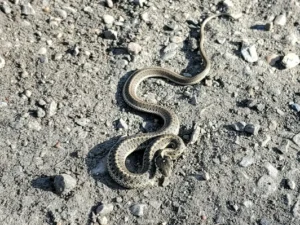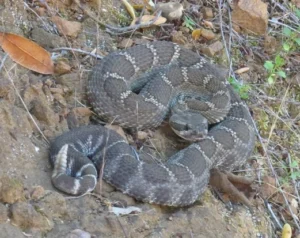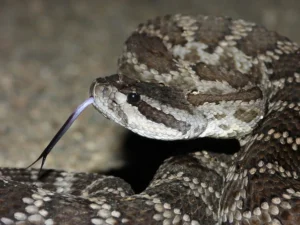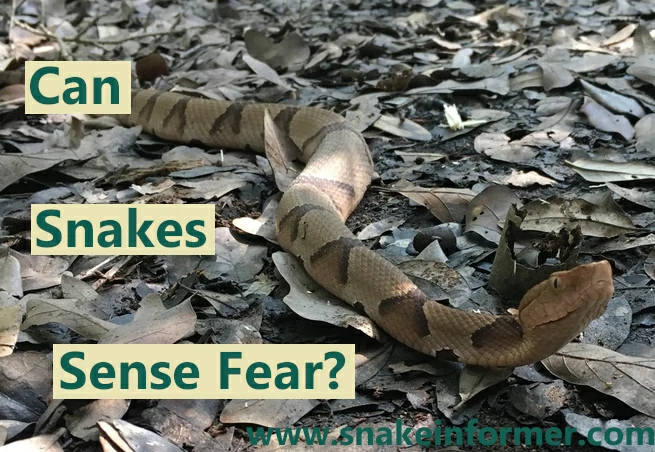When most people see a snake, their instinctive reaction is fear and panic. But can snakes actually sense when we are scared?
Snakes can not sense or understand human emotions like fear. However, they can react to how you act when you are sacred – such as sudden movements, stomping, or even increased body heat.
Snakes are very good at detecting change in their environment, and in other animals (including humans).
But that does not mean they can understand when you are scared.
Snakes Can Not Sense Human Emotions
Snakes in general do not feel or understand human emotions like fear.
Their brains are too simple and lack the complex structures needed to process emotions as humans or many mammals can.
Most of their brain activity involves basic functions like hunting for food, avoiding predators, and finding mates.

That said, snakes are very good at detecting behaviors, and physical changes many of which often come with fear.
For example, when a person is scared, they might make sudden movements, scream, or breathe more heavily.
All of this can picked up by snakes, and they might react to it.
In simpler terms, a snake does see you as “scared”. It sees you as a moving object or possible threat, based on the movement you show when you are scared.
Snakes do not recognize any human emotions. Instead, they respond based on physical signs such as movement, vibrations, or body heat.
Snakes Can Detect Changes in Your Behavior Associated With Fear
Although snakes do not “sense” or recognize fear, they can pick up on, and react to some physical signals related to fear.
1. Sudden Movement
One of the most noticeable reactions to fear is sudden or erratic movement.
When people are startled or frightened, by a snake, they often react by jumping back, stomping their feet, trembling, or even running away.
These quick, forceful actions create vibrations in the ground and air, which snakes can sense very well.
Although snakes don’t have outer ears like mammals, they are not deaf.
They have an inner ear structure connected to their jawbone, allowing them to detect low-frequency ground vibrations effectively.
When you walk, run, or even shift your weight, these vibrations travel through the earth.
The snake picks them up through its body, so it can “feel” movement without seeing it.
This sensitivity is vital for a snake’s survival.
In the wild, ground vibrations might mean a large predator, a herd of animals, or a human approaching.
When someone is afraid and moves suddenly, the snake doesn’t see that as “fear”; it recognizes it as a possible danger.
Depending on the species and situation, the snake might flee, hide, or adopt a defensive posture.
2. Increased Body Heat
Some snakes, such as pythons, boas, and pit vipers (like rattlesnakes and copperheads), have a special ability to detect infrared radiation or body heat.
This comes from structures called pit organs, which are small, heat-sensitive depressions between their eyes and nostrils.

These organs let snakes “see” the heat signatures of nearby animals, giving them a kind of heat vision. This is very helpful for hunting and avoiding danger.
To these snakes, a warm-blooded animal stands out as a glowing target, especially when the environment around the animal is cool.
This ability allows them to find prey, such as rodents and birds, and also to avoid predators (including humans), even in complete darkness.
When you get scared, your heart rate increases, which can raise your body temperature slightly, especially in your face.
This increase in body warmth can be detected by a snake’s heat-sensing system.
However, snakes do not interpret the increase in body temperature as
Instead, you become a warmer and more visible animal in their environment.
A snake may possibly see you as a threat – and it may react by getting into a defensive posture, or fleeing.
Snakes Can Not “Smell Fear”
There is a common idea that snakes can “smell” fear, however, this is not true.
Snakes don’t have a typical sense of smell like mammals. Instead, they use a special organ called Jacobson’s organ, located in the roof of their mouth.
To “smell,” a snake flicks its forked tongue in the air or on surfaces to gather tiny chemical particles.
It then inserts the tongue tips into Jacobson’s organ to analyze these chemicals.

This system is very sensitive and is mainly used for tracking prey, sensing predators, or finding potential mates.
When humans are scared, stressed, or anxious, we release certain chemicals and pheromones.
However, there is no scientific proof that can recognize or interpret any of the specific chemicals associated with fear.
While snakes may notice changes in your body odor, they do not associate it with fear, or any other emotions.
It’s Important to Stay Calm During Snake Encounters
The best way to handle an unexpected encounter with a snake is to stay calm and still.
Reacting with sudden movements can make the snake feel threatened by your presence.
To the snake:
- Less Movement = Less Threat
Sudden movements can startle a snake and trigger a defensive response. Staying still helps you avoid looking dangerous.
- Fewer Vibrations = Less Detection
Snakes sense ground vibrations. Panicked stomping or shifting can alert them. Calm behavior makes you less noticeable.
- Lower Heat & Scent = Less Noticeable
Fear raises your body heat and scent. Some snakes detect heat through pit organs. Staying calm minimizes these signals.
Generally, when you stay calm most snakes won’t see you as a danger.
Once calm, back away and realize that you are invading the snake’s space (not the other way around).
The majority of venomous snake bites in the US happen when people have already seen a snake, but try to interact with it rather than just moving away.
It’s best to leave the snake alone and move on.
Conclusion
It’s easy to think a snake “senses” fear when it suddenly reacts to us.
However, snakes cannot sense or understand human emotions.
Instead, they are very good at noticing physical cues in their environment.
This means that even though a snake doesn’t grasp the idea of “fear” like we do, it can still notice the changes in your body and behavior that fear causes.
Sources:
Macrì S, Aalto IM, Allemand R, Di-Poï N. Reconstructing the origin and early evolution of the snake brain. Sci Adv. 2023 Sep 29;9(39):eadi6888. doi: 10.1126/sciadv.adi6888.
Steimer T. The biology of fear- and anxiety-related behaviors. Dialogues Clin Neurosci. 2002 Sep;4(3):231-49. doi: 10.31887/DCNS.2002.4.3/tsteimer.
Daryl Austin (2024). Here’s what fear does to your brain and your body. National Geographic
Hi, my name is Ezra Mushala, i have been interested animals all my life. I am the main author and editor here at snakeinformer.com.

